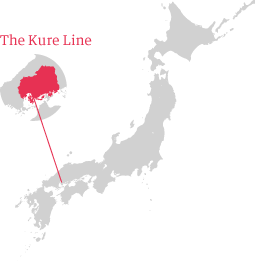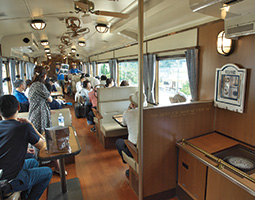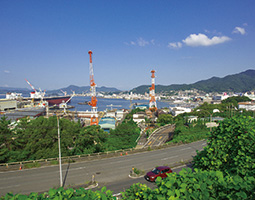Home > Highlighting JAPAN > Highlighting Japan November 2019 > A Trip by Local Train
Highlighting JAPAN
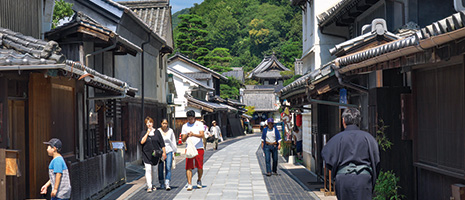
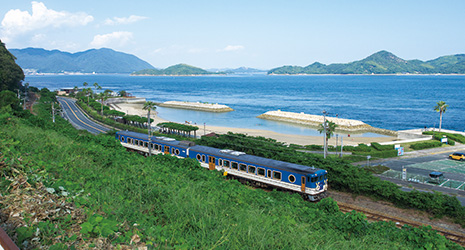
- PREVIOUS
- NEXT
Experiencing the Seto Inland Sea by Train
The Kure Line in Hiroshima Prefecture offers passengers beautiful views of the Seto Inland Sea and access to historic port towns and islands along the route.
The Kure Line, operated by West Japan Railway Company (JR West), in Hiroshima Prefecture connects the 87 kilometers between Mihara Station in Mihara City, where the San’yo Shinkansen bullet train stops, and Kaitaichi Station in Kaita Town in about two hours and 20 minutes. Much of the Line, which was completed in 1935, runs close to the Seto Inland Sea.
“Some sections of the Kure Line run right along the coastline,” says Nakano Yuta of JR West Hiroshima Branch. “Passengers can enjoy the beautiful scenery of the Seto Inland Sea with its many islands from the train windows.”
A sightseeing train that allows passengers to fully enjoy the scenery of the Seto Inland Sea as though on a sea trip is Setouchi Marine View. The two-car train is painted a marine blue and the front is dressed with paddles and a lifebuoy. Inside, the train is decorated with compasses and nautical charts evoking a cruise ship ambience. The train makes one round trip daily between Hiroshima Station and Onomichi Station via the Kure Line, mainly on weekends and holidays.
“Setouchi Marine View has large windows on the side of the train facing the sea so that passengers can fully enjoy the scenery. Box seats and sofa seats help make for a relaxing sightseeing experience. The views in the section between Tadanoumi Station and Aki-Saizaki Station are particularly beautiful. Here the train runs so close to the coast that passengers can enjoy the full expanse of the sea through the windows,” says Nakano.
The Seto Inland Sea has been an important maritime transportation hub and abundant fishing ground since ancient times, and there are many large and small coastal ports along its shores. Visiting ports close to a station is one of the attractions of the Kure Line. Kure is a major port on the Line. The port grew as a military base during the Meiji period (1868–1912) and has since developed as a port for domestic and international vessels, with many shipbuilding factories also operating after World War II. At Kure, visitors can see scenes unique to a shipbuilding town, such as dockyard sheds and a row of large cranes. The hit 2016 animated movie In This Corner of the World was set in Kure, drawing many people to the port to visit the bridges and warehouses that appeared in the movie.
Passengers on the Kure Line can cross to islands in the Seto Inland Sea by ferry from the ports along the way. Ohkunoshima, about 15 minutes from the port of Tadanoumi and Tadanoumi Station, is a popular island to visit. Ohkunoshima, which has a circumference of around four kilometers, is known as the “island of rabbits” and is inhabited by more than 1,000 wild rabbits. Many tourists from Japan and abroad visit just to see the rabbits hopping around on the island.
Traditional Japanese townscapes remain along the Kure Line. Takehara City Important Preservation District for Groups of Traditional Buildings, a 15-minute walk from Takehara, is particularly famous. Takehara has thrived as a leading Japanese salt producer since salt pans were created on the reclaimed land of Takehara Bay in the early Edo period (1603–1867). There is a row of houses and sake cellars built by merchants who made a fortune in the salt making, shipping and sake brewing businesses, mainly from the Edo period to the Meiji period in the preservation district, and the traditional Japanese townscapes are beautifully preserved. The district is often used as a location for shooting commercials, TV dramas and movies.
“In Takehara, which is known as the ‘little Kyoto of Aki’ [Aki is an old name for Hiroshima], tourism that makes use of its townscapes is flourishing. Visitors can have a relaxing time in hotels and cafés located in traditional houses,” says Nakano.
A ride on a Kure Line train delivers not only the beautiful scenery of the Seto Inland Sea but also the history and culture cultivated by those living alongside it.
- PREVIOUS
- NEXT
© 2009 Cabinet Office, Government of Japan
